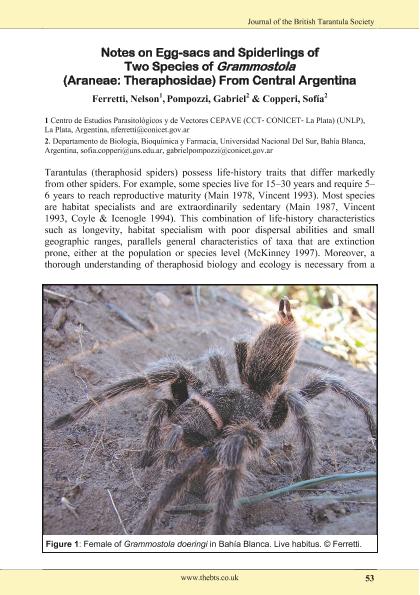Artículo
Notes on eggsacs and spiderlings of two species of Grammostola (Araneae: Theraphosidae) from Central Argentina
Fecha de publicación:
10/2012
Editorial:
British Tarantula Society
Revista:
Journal of the British Tarantula Society
ISSN:
0962-449X
Idioma:
Inglés
Tipo de recurso:
Artículo publicado
Clasificación temática:
Resumen
Two tarantula species inhabit south of Buenos Aires province, Argentina, Grammostola doeringi (Holmberg, 1881) and Grammostola vachoni Schiapelli & Gerschman, 1961. Grammostola doeringi can be easily found in nearby the locality of Bahía Blanca, where it lives in tubular burrows that are constructed in open fields. The other tarantula species, Grammostola vachoni, inhabits burrows constructed under stones in the rocky hills of northern and central Argentina. Adult females occupy soil burrows under stones and remain within, or close to, this shelter at all times. This tarantula species is common in the hilly zone in the locality of Sierra de la Ventana. Recently, distributional data analysis showed that maybe they could comprise sympatric species and studies on ethological reproductive isolation are being developed by the authors. Moreover, both species have the same reproductive period with walking males in spring in Southern Hemisphere (October ? December). The aim of this study is to present preliminary notes about the development of these two Grammostola species.
Palabras clave:
Tarantula
,
Argentina
,
Pet Commerce
Archivos asociados
Licencia
Identificadores
Colecciones
Articulos(CCT - BAHIA BLANCA)
Articulos de CTRO.CIENTIFICO TECNOL.CONICET - BAHIA BLANCA
Articulos de CTRO.CIENTIFICO TECNOL.CONICET - BAHIA BLANCA
Articulos(CEPAVE)
Articulos de CENTRO DE EST.PARASITOL.Y DE VECTORES (I)
Articulos de CENTRO DE EST.PARASITOL.Y DE VECTORES (I)
Citación
Ferretti, Nelson Edgardo; Pompozzi, Gabriel Alejandro; Copperi, Maria Sofia; Notes on eggsacs and spiderlings of two species of Grammostola (Araneae: Theraphosidae) from Central Argentina; British Tarantula Society; Journal of the British Tarantula Society; 27; 2; 10-2012; 53-61
Compartir




